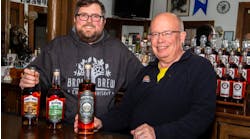While age 25 is considered young in human terms, among successful continuous improvement programs within manufacturing companies, that age is almost unheard of for its longevity. Even a decade of success can be difficult to find.
Yet such examples are out there. Freudenberg-NOK Sealing Technologies is this year celebrating a quarter-century of “Growtth,” an acronym for its lean implementation program Getting Rid of Waste Through Team Harmony. And manufacturer Belden Inc. has 10 years of lean experience under its belt with every sign of continued program growth.
Both manufacturers actively manage their lean programs to keep their workforces engaged, their programs growing and their businesses reaping the rewards. They share some of their insights with IndustryWeek.
Freudenberg-NOK Reaches a Milestone
By many measures, Growtth has been a winning formula for Freudenberg-NOK in the Americas. The company reports that it has completed more than 94,000 lean and Six Sigma projects in the past 25 years, representing savings of $414 million, and it has trained more than 130 certified Lean System and Six Sigma black belts. Further, Growtth “remains at the very heart of our organizational culture,” says Vicky Jandreau, director of Growtth in North America. “It’s become a way of doing business for us, a way of solving problems and building team cohesion.”
So perhaps the first lesson from Freudenberg-NOK: Make sure the program is important to the company—and its leadership. Growtth is both.
“There are only three directions you can go in business,” says Matthew Portu, president of Freudenberg-NOK Sealing Technologies. “You can go backwards and lose momentum, you can stay the course and hope that’s enough, or you can improve, get better at what you do, and grab new opportunities. Growtth defines our company and has enabled us to focus directly on option three for 25 years. It is as important as anything we do.”
Lesson No. 2: Don’t stand still. The Growtth program of today is not the Growtth of yesterday, and definitely it is not the Growtth of a quarter-century ago. For example, the program introduced just three lean tools and the kaizen methodology when it launched in 1992. Today the number of tools is around 14. And the company’s early focus on converting batch production to lean processes has given way in many instances to working more toward process refinements.
Rapid plant assessments remain a staple at Freudenberg-NOK, but even they come under regular scrutiny. The company has long used the assessment to measure its manufacturing plants’ level of lean implementation. The plants also are rated against one another, with titles bestowed on the “best” and “most improved” plant.
“A little competition is good. It keeps it fresh,” Jandreau says.
The assessment itself is regularly freshened, too. “Each year our corporate team gets together and we tweak the questions to drive people even higher, so that we always push toward that true north objective,” she says.
A Focus on Learning
As Growtth expands in scope, it is developing into a learning organization. “It’s being an organization where we just automatically share best practices. We all strive to help one another become the best we can possibly be. We have a lot of programs in place right now focused on that particular topic,” Jandreau says.
Which emphasizes Lesson No. 3: Always be learning. One example is what the manufacturer calls structured best practice exchange days, which were introduced within the past three years. They support the rapid plant assessments.
Mainly lean-tool focused, these exchange days are held at manufacturing sites that demonstrate some of the leading best practices in the company, with attendees given an opportunity to see a real-life implementation of that tool or practice. So, for example, plant personnel from a site that scored poorly on kanban would attend an exchange day held at the plant that scored very well on kanban.
“The hope and the expectation is that this plant would take the [best practice] back to their facility and, as much as possible, do a copy and paste,” explains the Growtth director.
The company has averaged approximately 20 of these exchange days annually during the past three years. With a modified approach for 2018, that number is likely to reach 28 next year.
On a related note are several new twists to Freudenberg-NOK’s training efforts, which include black belt training on lean systems, Six Sigma and a recently introduced lean administration. Approximately 10 to 20 people are certified each year.
Several years ago the company launched what it calls the “marketplace.” As part of the black belt training, certification candidates are asked to present their work at the company’s headquarters in Plymouth, Mich. The candidates set up stations and both explain their projects and field questions from leadership in that location.
“It was pretty successful, with a lot of participation from the Plymouth site, and I thought it was extremely exciting for the certification candidates because it allowed them the opportunity to speak to folks they wouldn’t normally speak to,” Jandreau says. “It was a very interactive time for them.”
Which leads to a fourth and final lesson: Use it or lose it. “You can’t keep a culture alive unless you’re training your people and you empower them to use it,” Jandreau says.
Belden’s Lean World Cup
Looking for a clever way to keep your workforce engaged in executing big improvements? Consider the example of St. Louis-based Belden Inc., a global manufacturer of connectivity and networking products. Belden has been practicing lean manufacturing for a decade now, introduced to the system by CEO John Stroup—alumnus of Danaher, where lean has a history that stretches back more than a quarter century. Belden holds an annual Lean World Cup competition.
“We get lots and lots and lots of participation because it’s a really big deal to be recognized,” says Jerry Rose, Belden vice president of lean enterprise. “It is recognized as a big accomplishment inside Belden.”
The competition operates somewhat as you might imagine. Teams from across the company are invited to submit breakthrough processes they achieved using lean methodologies and typically as a result of kaizen event activities. Judges winnow the entries, received as three-page applications, to five or six finalist teams who are then invited to Las Vegas for the finals. There, the finalist teams present their improvements over two days to several sets of judges and via multiple presentation methods. The event concludes with a banquet, where all the participants are recognized, the winning team is announced and trophies are handed out.
“[The teams] are excited about the opportunity to be seen as leaders, to be exposed as good lean practitioners—and honestly, going to Las Vegas and being treated as kings and queens for four or five days is a pretty good incentive as well,” Rose says.
The competition also lays waste to the Las Vegas catchphrase, “What happens in Vegas, stays in Vegas.” Throughout the event, the corporate communications staff write and post articles about goings-on on the intranet. Belden also captures the Lean World Cup via photography and videography, which is provided to group presidents and other leaders who then can broadly share it. And in 2018, adds Rose, “We’re going to socialize it to a much larger degree.”
The winning team in 2017 (for activities conducted in 2016) implemented a comprehensive value stream transformation, one whose elements included a set-up time reduction effort on a machining center that delivered dramatic improvements, and the combination of several operations and introduction of a clever poka yoke in an assembly area.
The competition is not limited to manufacturing operations, however. Past teams have included finance, for example. That team submitted an improvement that significantly shortened the time it took to close the end of each month. And a customer service team was among the finalists this year.
The common thread among Lean World Cup entries—from wherever they emerge—is that they represent breakthroughs, Rose says, meaning they can be broadly used across Belden and represent Belden values, strongly improve customer satisfaction and engagement, are repeatable, or demonstrate strong impacts in other ways.
Leaders Commit, Benefits Accrue
To be sure, the Lean World Cup is not without significant costs, both in time and money. Sending 100 to 120 people to Las Vegas for a week, or nearly that, is not cheap. Further, many of those people are Belden group presidents, vice presidents and other leadership team members, many of whom are judges in the Lean World Cup.
“It’s a significant investment in terms of time and money,” admits Rose, “because we think we get that much out of it.”
Indeed, the vice president of lean enterprise says among the biggest benefits of this annual competition is that it brings a wide variety of teams and functions globally together “to share stories and experiences around their lean activities, their lean journeys.”
Even more, he says, it provides the different businesses with the chance to physically see opportunities they may “never have dreamed about doing because they hadn’t been exposed to it,” Rose says. “There are always significant takeaways that can be used to in other businesses to improve their own internal processes.”





